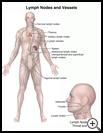
Lymphedema
________________________________________________________________________
KEY POINTS
- Lymphedema is swelling due to a buildup of lymph fluid in the fatty tissues just under the skin. The lymph system is part of your body's system for fighting infection.
- The treatment depends on the cause and may include keeping the swollen body part raised above the heart when able, gentle massage, and exercises.
- Follow the full course of treatment prescribed by your healthcare provider. Ask your healthcare provider how to take care of yourself at home.
________________________________________________________________________
What is lymphedema?
Lymphedema is swelling due to a buildup of lymph fluid in the fatty tissues just under the skin. The lymph system is part of your body's system for fighting infection. The lymph system consists of lymph nodes that store blood cells (lymphocytes) to fight infection and vessels that carry fluid, nutrients, and wastes between your body and your bloodstream.
What is the cause?
Lymphedema can happen when the lymph system is blocked and cannot drain fluid from the tissues. This may be caused by:
- Infection
- Radiation
- Injury
- Cancer
- Surgery to remove cancer and nearby lymph nodes
In rare cases, lymphedema happens because the lymph system did not form normally before you were born. In this case it is called primary or congenital lymphedema.
What are the symptoms?
Symptoms may include:
- Swelling of 1 or both arms or legs (the swelling usually gets worse during the day and better at night). You may notice that rings or shoes are tight
- A feeling of tightness, heaviness, or weakness in your arm or leg
- Pain, aching, or warmth in your arm or leg
- Redness of the skin of the arm or leg
Sometimes lymphedema develops very slowly. You may not notice it for 18 to 24 months after surgery, or even years after cancer treatment. You may have aching in your neck, shoulders, back, or hips caused by overuse of muscles, or changes in your posture caused by the increased weight of your swollen arm or leg.
How is it diagnosed?
Your healthcare provider will ask about your symptoms and medical history and examine you. You may have:
- An X-ray test that uses contrast dye injected into the lymph system
- An ultrasound, which uses sound waves to show pictures of the lymph system
- A CT scan, which uses X-rays and a computer to show detailed pictures of the lymph system
- An MRI, which uses a strong magnetic field and radio waves to show detailed pictures of parts of your body
Lymphedema is different from other types of edema you may have that come from heart failure or kidney failure.
How is it treated?
The treatment depends on the cause. Treatment may include:
- Keeping the swollen body part raised above the level of your heart, especially when you are sleeping
- Using compression stockings, boots, gloves, or sleeves
- Getting a gentle massage to help move fluid from the end of the limb toward the trunk of your body. At first, a trained therapist should do this, but you may learn how to do it yourself.
- Carefully exercising your arm or leg according to your healthcare provider's instructions
- Cleaning the skin carefully to prevent infection
- Taking antibiotics to treat or prevent infection
There is not cure for lymphedema, but early treatment helps with symptoms. Mild lymphedema may get better with treatment in a week. Sometimes the lymph ducts have been damaged to the point that even with treatment the lymphedema never completely goes away.
How can I take care of myself?
Follow the full course of treatment prescribed by your healthcare provider. Ask your healthcare provider:
- How long it will take to recover
- If there are activities you should avoid and when you can return to your normal activities
- How to take care of yourself at home
- What symptoms or problems you should watch for and what to do if you have them
Make sure you know when you should come back for a checkup.
How can I help prevent or control lymphedema?
- Learn about arm, leg, and skin care after surgery or radiation treatment.
- To help prevent injury and infection in the affected arm or leg:
- Use an electric razor for shaving.
- Wear gloves when gardening or cooking.
- Keep your feet covered when outdoors. Don’t go barefoot.
- Keep your feet clean and dry and wear cotton socks.
- Clean cuts with soap and water, then use antibacterial ointment.
- Avoid needle sticks, such as shots or blood draws, in the affected arm or leg.
- Avoid extreme hot or cold, which can damage the skin, such as from ice packs or heating pads left on too long.
- Do not overuse the affected arm or leg.
- Keep a healthy body weight.
- Do the exercises recommended by your healthcare provider.
- Do not put too much pressure on the arm or leg:
- Do not cross your legs while sitting.
- Wear loose jewelry. Wear clothes without tight bands.
- Use your unaffected arm to carry a handbag or wear a watch.
- Do not use blood pressure cuffs on the affected arm.
- Do not use elastic bandages or stockings with tight bands.
- Do not sit in one position for more than 30 minutes.
- Keep regular follow-up appointments with your healthcare provider.

